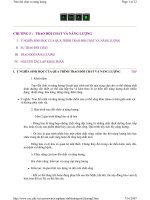5 5 deepwater overview
Bạn đang xem bản rút gọn của tài liệu. Xem và tải ngay bản đầy đủ của tài liệu tại đây (498.94 KB, 26 trang )
Introduction to Deepwater
Drilling Technology
COPYRIGHT © 2002,
All Rights Reserved
Topics to be covered
•
•
•
•
•
What is deepwater drilling?
Deepwater provinces - regional differences
Deepwater riser
Deepwater rigs and operations
High deepwater drilling costs and deepwater
alternatives slim hole, dual mud gradient systems
• Evolving deepwater drilling technology
– Deepwater field development concepts deep draft
caisson vessel (DDCV-SPAR) vs. TLP (tension leg
platforms)
• Challenges of deepwater technology
• Conclusions
COPYRIGHT © 2002,
All Rights Reserved
Introduction
• What is “Deepwater?”
– This is an evolving notion
– Presently considered to be water depth deeper than
1500 ft, ultra-deepwater meaning > 5000 ft of water
• Where is deepwater drilling taking place?
– Present water depth drilling record: 9111 ft (Brazil
2000); 6592 ft 1998; 5700 1982)
– World water depth record for a producing well: 6080
ft (Roncador field, Brazil, 1999)
COPYRIGHT © 2002,
All Rights Reserved
Deepwater Basins in 2000
COPYRIGHT © 2002,
All Rights Reserved
Deepwater Discoveries in the US
Gulf of Mexico (Water depth > 1500 ft)
• History: Jolliet (1722 ft, 1981), Tahoe (1500 ft, 1984),
Auger (2864 ft, 1987), …
• 112 deepwater discoveries at the end of 1999: 17 in
1999, 10 in 1998, 16 in 1997
COPYRIGHT © 2002,
All Rights Reserved
Deepwater Provinces
• Brazil
• Gulf of Mexico (GOM)
• West Africa
(Angola, Nigeria, Equatorial Guinea, Gabon)
• Others
– West of Shetland, Western Approaches, Norway
– Trinidad (1 discovery)
– Indonesia (confirmed-UNOCAL), Australia
– Israel, Egypt (exploration on-going)
– Plans in India, Pakistan, Tanzania
COPYRIGHT © 2002,
All Rights Reserved
Differences Between the
Deepwater Provinces
Gulf of Mexico
- Extremely high drilling cost
- Shallow water flows
- Very deep reservoirs
(multiple casing strings, ECD
problems, odd casing/hole sizes)
- Sub-salt drilling
- Slender well concept applicable
- Loop 7 eddy currents, hurricanes
- Direct application of dual
gradient drilling
Angola
- Shorter well duration
- Shallow reservoirs BML (leading to
near horizontal /high reach wells,
shallow kick-offs in unconsolidated
formations)
- well reach limited by ECD
problems
(impact on development scheme,
i.e. subsea vs. surfaceWHP)
- Slender well concept applicable
COPYRIGHT © 2002,
All Rights Reserved
Projected Deepwater
Expenditure Per Region
North America
8000
Middle East
$ million .
7000
Latin America
6000
Europe
5000
Australasia
Asia
4000
Africa
3000
2000
1000
0
1995
1996
1997
1998
1999
2000
2001
2002
2003
2004
Courtesy of World Deepwater Report 2000-2004, John Westwood Associates & Infield Systems Ltd
COPYRIGHT © 2002,
All Rights Reserved
Deepwater Activity Forecast
Courtesy of Oilfield Review
COPYRIGHT © 2002,
All Rights Reserved
Business Challenges!
• New ventures and exposure to organization
• 1st deepwater licenses for operator, drilling
contractor & service company personnel
• Water depths > 150m 3000 m
• Remote and demanding environment(s).
• New process and technology requirements
• New skills sets for personnel
• How to succeed first time !
COPYRIGHT © 2002,
All Rights Reserved
Technical Challenges!
•
•
•
•
•
•
•
•
•
•
Water / depth
Pressure / temperatures
Geo-science demands
Operating environment
Formation characteristics and
operating conditions (limits)
Wellbore stability
Wellbore quality
People, multidisciplinary skill set.
Operating procedures, guidelines
Loss, risk, performance management
COPYRIGHT © 2002,
All Rights Reserved
Unconsolidated Shallow Sediments
•
30” pipe is jetted in (with drill-ahead tool)
•
30” pipe is structural, not conductor. Usually 80 to 100 m long
•
20” pipe is conductor, not surface casing. It is run in open water
(26” hole drilled riserless).
•
On mobile offshore drilling units (MODU), BOPs and marine
risers are run on top, but no use of BOPs in 17-1/2” hole (No shutin).
•
13-3/8” casing acting as surface casing
•
Very low fracture gradients
COPYRIGHT © 2002,
All Rights Reserved
Narrow Margin Between
Fracture and Pore Pressure
•
•
•
Well control issue: reduced kick tolerance
Leads to multiple casing strings (especially
with deep below mud level (BML)
reservoirs)
Solutions:
– Very close monitoring of mud weight
(equivalent circulating density (ECD)
management)
– Use of abnormal pressure while drilling
(APWD) tools to know ECD & kick
detection
– Requirement for pore pressure prediction
– Highly sensitive kick detection
equipment
– Procedures (breaking mud gel)
COPYRIGHT © 2002,
All Rights Reserved
Sea Ttemperature Profile
Temp Gradient in sea water
Treturn
Tinjection
Temperature
drop in drill pipe
Temperature
drop in annulus
Tcasing
Geothermal Profile
Tannulus
COPYRIGHT © 2002,
All Rights Reserved
Drilling Fluids
• Low fracture gradients (hole cleaning, ECD, lost circulation)
• Low temperatures (high viscosity, gel, impact on ECD, and swab
and surge)
• Key issue: very close mud weight monitoring
• Solutions
– ECD control solutions: by design & use of bi-center bits
– Prevention: APWD, virtual hydraulics (ECD modeling
accounting for temperature, solids, surge)
– Procedures: limitation of tripping speed, breaking mud gel
while tipping
• Wellbore stability: inherent problem
• Possibility of gas hydrates (gas, water, T, P, mud type inhibitors
prediction software)
COPYRIGHT © 2002,
All Rights Reserved
Deepwater Cementing
•
Possible lost circulation due to low fracture
gradients: extremely ECD critical
•
Low temperature affecting the shallow
casing strings (proprietary software for
temperature prediction)
•
Light weight slurry with adequate
compressive strength and acceptable setting
time: solution = special/proprietary cement
systems
•
ECD monitoring procedures for surge,
circulation to break gel, and controlled
slurry displacement
COPYRIGHT © 2002,
All Rights Reserved
Deepwater Well Control Specifics
•
Low fracture gradients, low temperature (high
swab and surge pressures)
•
No riser margin
•
Very low kick tolerance
•
High choke line friction losses, low MAASP
•
Hydrates
•
Trapped gas in the BOPs, handling gas in riser
(OBM, …)
•
Training of personnel essential (Drilling Co. & Oil
Co.)
COPYRIGHT © 2002,
All Rights Reserved
Riser Margin in Deepwater
Assuming a 12 ppg equivalent pore pressure at 7000 ft
drilling depth
–In 1000 ft of water: MW with riser margin = 12.6 ppg
–In 2000 ft of water: MW with riser margin = 13.4 ppg
–In 3000 ft of water: MW with riser margin = 14.6 ppg
• Riser margin: non-existing in deepwater
• No real double barrier with a SWHP or a surface BOP.
COPYRIGHT © 2002,
All Rights Reserved
Low Kick Tolerance in Deepwater
Assuming TD = 13000 ft, shoe @ 10000 ft
MW = 13.0 ppg, pore pressure = 13.5 ppg eq.
–In 1000 ft of water: kick tolerance = 180 bbls
–In 2000 ft of water: kick tolerance = 70 bbls
–In 3000 ft of water: kick tolerance < 10 bbls
• Kick circulated out likely to cause underground blowout
& cratering
• HIGHLY SENSITIVE KICK DETECTION
EQUIPMENT & annular pressure while drilling
(APWD)
• Prevention: importance of pore pressure prediction
COPYRIGHT © 2002,
All Rights Reserved
Hydrates
Causes
Prevention
• High pressure
• Pressure reduction (use the
lowest safe mud weight)
• Presence of natural gas
and water
• Low temperature
• Primary well control, i.e.
no gas in wellbore.
conditions are favorable in • Increase temperature, or
deepwater for formation of change fluid type or use
gas
inhibitors in the drilling
fluid
COPYRIGHT © 2002,
All Rights Reserved
Deepwater Well Testing
• Use of Sen Tree 3 (E-H control)
• Use of Sen Tree 7 (MUX) for large bore
• Downhole DST (no hydrocarbons at
surface)
• Only samples required? Cost effective
solution is low-shock MDT sampler (save
costly DST)
COPYRIGHT © 2002,
All Rights Reserved
Deepwater Risers
• Marine riser (mobile offshore
drilling unit (MODU)): 21” OD,
19” OD
• Drilling risers - tension leg
platform (TLP), deep draft caisson
vessel (DDCV): several options
(LP, HP, inner riser)
• Riser wear monitoring is essential
COPYRIGHT © 2002,
All Rights Reserved
Deepwater Rig & Operations
• Mooring/Station keeping capability
• BOPs
– Enhanced BOP control system (MUX)
– Larger subsea accumulator capacity
• Riser with buoyancy material, high tensioning capacity
• Much larger variable deck load (>5000 MT)
– Extra mud and riser storage required
• Guideliness system, ROV
• High daily rate …..
COPYRIGHT © 2002,
All Rights Reserved
High Deepwater Drilling Costs
•
Daily spread rate of a deepwater rig: $300 K minimum (primarily
due to rig cost and rig market)
•
How to reduce costs?
•
Saving on drilling time (parallel operations can lead to 20 to 35%
savings)
•
Less wells (multilaterals, horizontals, optimized well placements,
etc..)
•
Alternative rigs (use of 2nd and 3rd generation semi-subs
•
Alternative well design (slender well)
•
Alternative drilling concept (dual gradient drilling)
COPYRIGHT © 2002,
All Rights Reserved
Environmental Challenges
• Existing guidelines designed for onshore, swamps, and
shallow offshore activities must be modified
• New environmental concerns such as effect of deep
drilling activities on aquatic life and spill handling must
be addressed
• Monitoring operations and activities in deep terrain,
turbulence, and adverse weather conditions
• Needs precision equipment, MANPOWER, & SKILLED
PERSONNEL
COPYRIGHT © 2002,
All Rights Reserved









